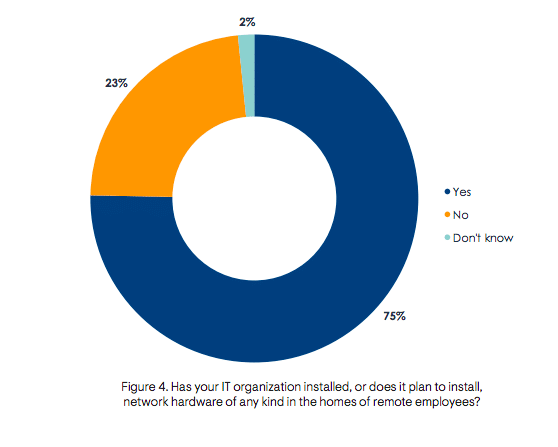EMA’s Post-Pandemic Networking Report: Enabling the Work-From-Anywhere Enterprise
Among the first extensive studies evaluating how network teams are adjusting to the massive shift to WFH.
Download 44pp. Summary Report
Exec Summary:
The COVID-19 pandemic forced hundreds of thousands of companies to send their employees home indefinitely. As the world starts inching toward a post-pandemic future, it’s clear that most companies will allow many employees to work from home forever.
This research, based on a survey of 312 IT professionals, explores how enterprise IT organizations are adjusting their network infrastructure and operations to the massive and permanent increase in people who are working from home. It also explores the ripple effects this paradigm shift is having on on-premises network infrastructure.
Key Findings
 1) 85% of those surveyed indicate that WFH is permanent.
1) 85% of those surveyed indicate that WFH is permanent.
2) Only 31% of IT organizations are fully successful with supporting the networking requirements of users who work from home
◦ Budget issues and infrastructure complexity are their biggest challenges
3) 75% of IT organizations are installing network hardware in the homes of some end users
◦ Network security and Wi-Fi are the most typical network functions running on this hardware
4) 72% of IT organizations are installing wireless WAN connectivity (4G and 5G) in the homes of some end users
5) 78% of IT organizations are deploying SD-WAN in the homes of end users
◦ 16% take a software-only approach to deploying SD-WAN in homes
6) The pandemic prompted 81% of IT organizations to launch or accelerate their engagement with secure access service edge (SASE) technology
7) 96% of IT organizations are allocating budget for enabling network monitoring and troubleshooting toolsets to support end users who work from home
8) Network operations teams need tools that offer security-related insights, dashboards, and reporting on home office networks, and more scalability
9) Despite the expansion of remote work, 61% of enterprises are increasing their investments in on-premises local network infrastructures
◦ This expanded investment is primarily driven by new security requirements, bandwidth demand, and office mobility requirements
10) Nearly 85% of IT organizations say the pandemic has led to interest in the long-term use of location-based services on their wireless LAN infrastructures, particularly:
◦ Productivity optimization, such as floating desk and conference room availability management
◦ Room occupancy enforcement
◦ Smart HVAC
11) 59% of IT organizations have increased their investment plans for SD-WAN
installed in corporate offices, despite the work-from-home surge
◦ These investments are primarily driven by new security requirements and cloud access requirements
12) 91% of network teams permanently expanded their use of network automation during the pandemic






